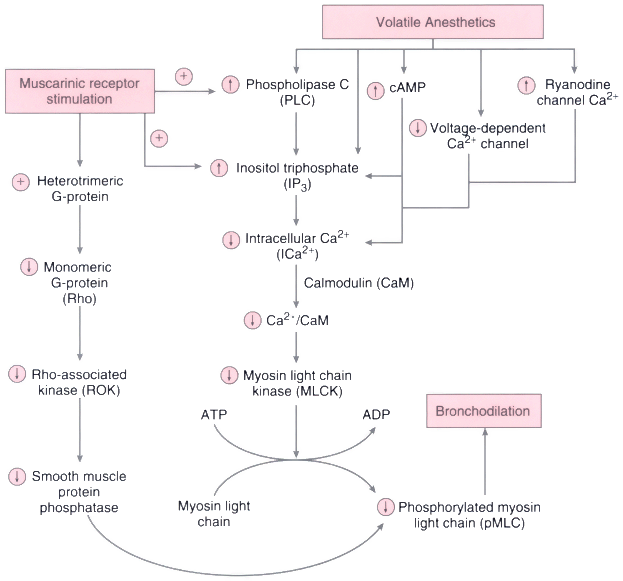 |
 |
Figure 6-3
Proposed signaling pathways underlying volatile anesthetic
(specifically halothane)-induced bronchodilation or inhibition of muscarinic agonist-induced
contraction of airway smooth muscle, or both mechanisms. Signal transduction involving
Rho protein is supported by work from Warner and coworkers on a role of halothane
to decrease Ca2+
sensitivity rather than a change in ICa2+
content. CaM, calmodulin; ICa2+
intracellular Ca2+
; IP3, inositol
triphosphate; MLC, myosin light chain; MLCK, myosin light chain kinase; pMLC, phosphorylated
myosin light chain; Rho, monomeric G protein; ROK, Rho-associated kinase; RyR, ryanodine
channels; SMPP, smooth muscle protein phosphatase; SR, sarcoplasmic reticulum; VDC,
voltage-dependent Ca2+
channels; encircled plus sign,
excitatory action of muscarinic receptor agonist; encircled
up arrow, represents activation or increase due to volatile anesthetic;
encircled down arrow, inhibition or decrease due
to volatile anesthetic. (Adapted from Hanazaki M, Jones KA, Perkins WJ,
et al: Halothane increases smooth muscle protein phosphatase in airway smooth muscle.
Anesthesiology 94:129, 2001 and from Pabelick CM, Prakash YS, Kannan MS, et al:
Effects of halothane on sarcoplasmic reticulum calcium release channels in porcine
airway smooth muscle cells. Anesthesiology 95:207, 2001.)

 |
